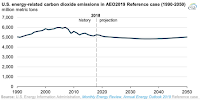Carbon dioxide emissions from S energy consumption will remain near current levels through 2050, according to projections in EIA’s Annual Energy Outlook 2019. The AEO2019 Reference case, which reflects no changes to current laws and regulations and extends current trends in technology, projects that US energy-related CO2 emissions will be 5,019 million metric tons in 2050—4% below their 2018 value—as emissions associated with coal and petroleum consumption fall and emissions from natural gas consumption rise.
Energy-related CO2 emissions generally follow energy consumption trends. In the United States emissions associated with the consumption of petroleum fuels—motor gasoline, distillate, jet fuel, and more—have consistently made up the largest portion of CO2 emissions. In 2018, the transportation sector’s consumption accounted for 78% of US CO2 emissions from petroleum and more than one-third of all US energy-related CO2 emissions.
Petroleum emissions from other sectors have fallen in recent years as equipment and processes that use petroleum fuels have been replaced by those using other fuels, in particular, natural gas.
In the transportation sector, consumption and emissions trends in the past have been driven by changes in travel demand, fuel prices, and fuel economy regulations. In EIA’s AEO2019 Reference case projection, current fuel economy standards stop requiring additional efficiency improvements in 2025 for light-duty vehicles and in 2027 for heavy-duty vehicles, reflecting existing regulations. As travel demand continues to rise, transportation consumption and emissions increase.
Read more at EIA Projects US Energy-Related CO2 Emissions to Remain Near Current Level Through 2050; Increased Natural Gas Consumption
Read more at EIA Projects US Energy-Related CO2 Emissions to Remain Near Current Level Through 2050; Increased Natural Gas Consumption

No comments:
Post a Comment